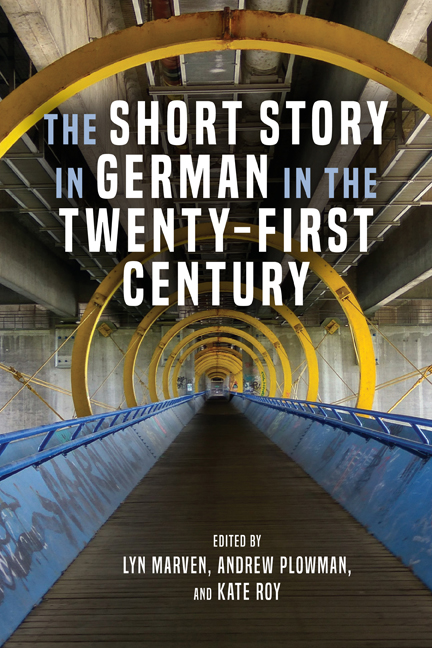Book contents
- Frontmatter
- Contents
- Acknowledgments
- Note on Translations
- Introduction to the Contemporary Short Story in German
- 1 Berlin Shorts: The German Capital in the Short Story of the Twenty-First Century
- 2 The German Crime Story in the Twenty-First Century
- 3 Performance, Performativity, and the Contemporary German Kurzgeschichte
- 4 Cramped Spaces, Creative Bottlenecks: Sudabeh Mohafez’s Das Zehn-Zeilen-Buch and the Short-Short
- 5 Bodo Kirchhoff’s Widerfahrnis: A Novelle for Our Time?
- 6 The Liminal Space of the Short Story: Clemens Meyer’s Die Nacht, die Lichter and Die stillen Trabanten
- 7 Framing the Presence: Judith Hermann’s Lettipark
- 8 Of Unhomed Subjects and Unsettled Voices: Alois Hotschnig’s Die Kinder Beruhigte Das Nicht
- 9 Authorial Development and Fluid Spaces in the “Complete Stories”: Peter Stamm’s Der Lauf Der Dinge
- 10 On Disappearing: Reading Ulrike Almut Sandig with Sylvia Bovenschen
- 11 Metamorphic Becomings: Yoko Tawada’s Opium Für Ovid: Ein Kopfkissenbuch Von 22 Frauen
- 12 Melinda Nadj Abonji and Jurczok 1001: Performance, Politics, and Poetry
- 13 Rhizomatic Wanderings: The Writings of Gabriele Petricek
- 14 Trends and Issues in the Contemporary German-Language Short Story
- Appendix: Contemporary German-Language Short Stories in Translation
- Bibliography of Primary Texts
- Notes on the Contributors
- Index
4 - Cramped Spaces, Creative Bottlenecks: Sudabeh Mohafez’s Das Zehn-Zeilen-Buch and the Short-Short
Published online by Cambridge University Press: 09 February 2021
- Frontmatter
- Contents
- Acknowledgments
- Note on Translations
- Introduction to the Contemporary Short Story in German
- 1 Berlin Shorts: The German Capital in the Short Story of the Twenty-First Century
- 2 The German Crime Story in the Twenty-First Century
- 3 Performance, Performativity, and the Contemporary German Kurzgeschichte
- 4 Cramped Spaces, Creative Bottlenecks: Sudabeh Mohafez’s Das Zehn-Zeilen-Buch and the Short-Short
- 5 Bodo Kirchhoff’s Widerfahrnis: A Novelle for Our Time?
- 6 The Liminal Space of the Short Story: Clemens Meyer’s Die Nacht, die Lichter and Die stillen Trabanten
- 7 Framing the Presence: Judith Hermann’s Lettipark
- 8 Of Unhomed Subjects and Unsettled Voices: Alois Hotschnig’s Die Kinder Beruhigte Das Nicht
- 9 Authorial Development and Fluid Spaces in the “Complete Stories”: Peter Stamm’s Der Lauf Der Dinge
- 10 On Disappearing: Reading Ulrike Almut Sandig with Sylvia Bovenschen
- 11 Metamorphic Becomings: Yoko Tawada’s Opium Für Ovid: Ein Kopfkissenbuch Von 22 Frauen
- 12 Melinda Nadj Abonji and Jurczok 1001: Performance, Politics, and Poetry
- 13 Rhizomatic Wanderings: The Writings of Gabriele Petricek
- 14 Trends and Issues in the Contemporary German-Language Short Story
- Appendix: Contemporary German-Language Short Stories in Translation
- Bibliography of Primary Texts
- Notes on the Contributors
- Index
Summary
max ten minutes writing, max two reworkings, max 852 characters with spaces (plus/minus). then: send the message in a bottle out into the worldwide-swell. and all of that, if the sea isn't too rough, daily. the sea is often rough though. then: hoist the sail and away …
—Sudabeh MohafezTHERE IS “NO CRITICAL CONSENSUS” on where the shortest form of the short story comes from, no real agreement on its many possible names, and an endless debate on its length. “How short can a story be before it degenerates into something else?” asks Michael Basseler, while William Nelles plumps for 700 words as an upper limit; microfiction as a whole seems generally considered to be any piece of writing shorter than 1000 words. Nothing about the form is set in stone. Whatever the definition, however, Sudabeh Mohafez's self-imposed rules, above, as they appear on her prize-winning literary blog “zehn zeilen” (ten lines), where she writes as eukapirates under the heading “was die piratin hiertut” (what the pirate's doing here), situate her clearly within this loose category of microfiction.
The short-short is not a new form. While it may be particularly popular in and well suited to the twenty-first century, its “generic slipperiness” is evident from the number of speculated antecedents. Hailing from “Japan, China, Latin America … Europe” and beyond, these possible generators of short-shorts include parables or fables, Denkbilder (“thought images”), sonnets or ghazals,and haibun, a short form of Japanese writing related to haiku—a form at which Sudabeh Mohafez has also tried her hand; they could even be miniatures, both in the sense of the painting traditions capturing grand narratives within a single small image, and the modernist prose miniatures of which Andreas Huyssen writes, which encapsulate lightning images and movement in photographic style. Both in the German-language context and internationally, Kafka is almost omnipresent as a touchstone, evoked by nearly every critical discussion of short-shorts. For Nelles, “two thirds” of Kafka's stories published during his lifetime qualify as microfictions.
- Type
- Chapter
- Information
- The Short Story in German in the Twenty-First Century , pp. 76 - 96Publisher: Boydell & BrewerPrint publication year: 2020



